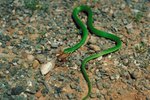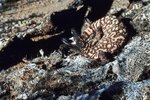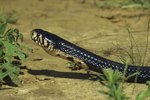
The eastern green mamba (Dendroaspis angusticeps), western green mamba (Dendroaspis viridis) and boomslang (Dispholidus typus) are venomous snakes native to Africa. These arboreal species spend most of their lives in trees, and all three are various shades of green. Clear divisions in where they live and a few noticeable characteristics set them apart. However, you don’t want to approach any of these snakes, unless it’s from the other side of a herpetology exhibit.
Different Distributions
The boomslang is widely distributed throughout lowland forests and savannas of sub-Saharan central and southern Africa. Green mambas have smaller distributions. The western species is found along the southern portions of West Africa in tropical rainforests and woodlands, while the eastern green mamba resides along the eastern coast of Africa, south from Kenya to South Africa, in woodlands and coastal bushlands.
Green and Greener
Boomslangs come in various shades of green, from dusty olive to bright green, and blend in well with their surroundings. This snake’s scales are very large and keeled – meaning ridged -- giving him a rough appearance. The scales are outlined in black. Green mambas, both the eastern and western species, are vivid, glossy green. Some specimens of western green mamba have keels outlined in black on their heads, but the scales are smooth. The three species are similar in length, with the western green mamba averaging 6 feet long, about a foot longer than the other two species.
Very Venomous
These are three highly toxic snakes. The boomslang’s venom is hemotoxic (affecting the blood) and stops blood from clotting. He can fold his fangs into his mouth when he’s not using them, and he appears to chew his prey when he bites. This snake is in the family Colubridae. The venom of green mambas contains neurotoxins and cardiotoxins (affecting the brain and heart, respectively) that cause death by respiratory paralysis. Mambas are in the Elapidae family, most of which are venomous.
Tree Hugging
All three of these snakes are arboreal, spending most of their lives in trees. They will come down to forage, to hunt prey or to find water. The boomslang even mates in trees. Mambas mate on the ground, and males compete for females by engaging in twisting, wrestling rituals than can last for hours.
References
- University of Michigan: Animal Diversity Web: Dispholidus typus: Boomslang
- ReptileChannel.com: Green Mamba Species Profile
- Branson's Wild World: West African Green Mamba
- University of Adelaide: Clinical Toxinology Resources: Dendroaspis angusticeps
- University of Adelaide: Clinical Toxinology Resources: Dispholidus typus
Photo Credits
-
Chad Baker/Digital Vision/Getty Images
Writer Bio
Leslie Darling has been a writer since 2003, writing regularly for "Mississippi Magazine" and "South Mississippi Living," specializing in food and wine, animals and pets, and all things Southern. She is a graduate of the University of New Orleans.




